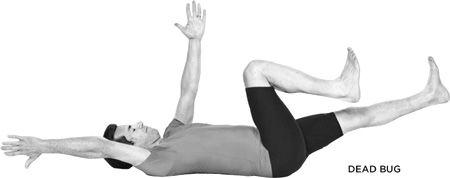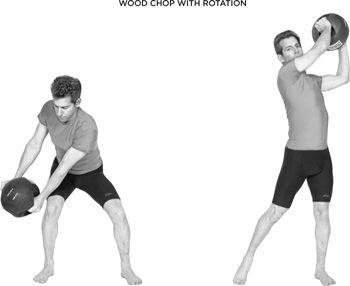Authors: Rob Destefano,Joseph Hooper
Tags: #Health & Fitness, #General, #Pain Management, #Healing, #Non-Fiction
Muscle Medicine: The Revolutionary Approach to Maintaining, Strengthening, and Repairing Your Muscles and Joints (11 page)

The ideal push-up: Assume the familiar prone push-up position. Your feet should be about shoulder-width apart with your hands braced on the floor, next to your shoulders. The shoulders and upper back should be pulled back and “down,” not hunched up or rounded. First make sure you can hold that raised push-up position: arms straight, face down with neck in a straight, “neutral” position, back flat, abs held in, no sagging the hips. You may feel your ab muscles shaking after a few seconds! Then slowly lower your body (count to three) as one unit, leading with your chest, until your elbows are at ninety degrees and hold for a count of one. Come back up to the starting position, counting one or two. Inhale on the way down, exhale on the way up. Your abdominal muscles should be firing the whole time, helping to keep your body straight. Repeat as many times as you can comfortably manage with good form. Bad form is letting your midsection drop, not going low enough, or moving your hands forward and hunching your shoulders. The motion should be slow and controlled, not fast and sloppy.

Lots of people can’t do one proper push-up. Doing push-ups from the knees-down position is a common modification, but we prefer staying in the straight-line position and doing the push-ups against an angled surface, for instance, hands braced on the kitchen counter, the stairs, or a park bench. Seniors with physical limitations can do them from a standing position, against the wall. With your arms
fully extended and hands flat against the wall or bench in front of you, relax your elbows and lean into the wall or bench. Then push back to your starting position, keeping your body straight the whole time. This doubles as a good exercise to develop the strength and the reflexes needed to break a fall with the hands and arms.
Push-ups can be made tougher as well. Modify the starting position by bringing the feet closer together or drop your chest closer to the floor. Do the push-up with one foot off the ground or with both feet raised, resting on a chair, bench, or a stability ball.
The ideal pull-up: Not too many people have a pull-up bar bolted to a wall at home, so you’ll likely have to visit a local playground or make the trip to the gym. Grip the bar with the palms facing out and the hands a little wider than shoulders’ width apart. The arms should be straight at the start of the movement, whether you are hanging or using a support. Tighten your ab muscles, keep the shoulder blades together and down, and then slowly pull your body up as you count to one or two, leading with the chest and squeezing the shoulders back. Exhale at the top. Your chin should clear the bar, but do not jut it forward or pull yourself forward over the bar. Hold for one count, then, inhaling, lower yourself to a three count. Keep your

shoulders back and down and do not round your back or shoulders! You may find it easier to stay in balance by crossing your ankles and flexing your knees. Stop before your form begins to crumble.
Lots of people can’t do a single proper pull-up. No shame there. Find a low, chest-height playground bar. Standing with your chest next to the bar, grasp the bar and lean backward until your arms are fully extended. To make it harder, move your feet farther in front of the bar so your body is at a steeper angle. Pull yourself toward the bar until your chest touches it, and repeat for the number of repetitions in your set. An even better solution is the Gravitron machine at the gym, which uses a counterweight system to let you adjust the amount of resistance as you move your body up and down. There are several grips so you can work a range of muscles.
Core
The plank: This is one of the best, and simplest, ways to work the abdominal muscles. Assume the prone push-up position, but with your weight on your forearms, elbows bent at about forty-five degrees, and hands angling in toward the center, in a fist position, thumbs-up. Keep the shoulders down, back straight, hips up, and hold the position as long as you can maintain good form. Try fifteen, then thirty, then forty-five seconds, and so on. You can further increase the burn by resting your forearms on a stability ball. To work the oblique abdominal muscles, switch to a side-plank position. Lie on your side and elevate youself by putting your weight on one forearm, perpendicular to the body, elbow bent at ninety degrees. Your legs are stacked one on top of the other; the hand of your non-weight-bearing arm is resting on your raised hip. Hold the pose as long as you can keep your body in a still, straight line. Switch sides and repeat. (See pages 163 snd 164.)
Stability-ball crunch: Probably the most common core exercise. The standard crunch is not your only option. It doesn’t target the core as a unit, you can cheat with body momentum, and it can stress the neck. A better option is the stability-ball crunch. Stretch your back out on a stability ball. With your knees bent and feet planted on the floor, lift your shoulder blades off the ball, two or three counts coming up, the same coming down. Five or ten stability-ball crunches can work your abs more thoroughly than as many or more “classic” crunches. (See page 165.)
The stability ball, however, can be very challenging for those with back and
neck issues or balancing issues. An alternative is a variation on the standard floor crunch. Lying on your back, bend your knees slightly to take the pressure off your lower back. Put your hands by your ears (without pushing your head forward) and lift your upper body slightly off the ground by contracting your abs and bringing your chest toward the ceiling. If your neck feels strained, use your hands and fingertips to support your head, taking pressure off your neck.
Dead bug: Here’s an alternative to the stability-ball crunch that’s better for people with neck- or shoulder-muscle issues, the easy-to-remember Dead bug. Lie on your back, keeping the spine neutral at all times. Bring both feet up, knees directly over your hips and bent at a ninety-degree angle. Raise both arms, then extend your left arm straight back behind you and at the same time drop your right heel and extend your right leg straight out, hovering just above the ground. Keep your abdominal muscles engaged. Then slowly bring your legs and arms back to the starting position and repeat, this time extending the right arm behind and the left leg in front. Do as many repetitions as you can manage with good form, keeping your abs engaged and back flat against the floor. Only lower your arms and legs as far as you can with control.

Superman: This is a great exercise to work the abdominals and the lower-back muscles. Lie facedown on a mat or some other forgiving flat surface with your legs together. Extend your arms behind you, keeping them close by your sides, with your palms facing up and thumbs pointing up. Extend and lift your torso at the waist, so your arms, chest, and torso all lift off the ground. Keep your neck straight,
your head in a “neutral” position, and your shoulder blades squeezed together and away from your ears. Hold the pose for thirty to forty-five seconds or as long as you can manage with good form, then relax and repeat. (See page 162.)
Lower Body
Body-weight squats: This is a great workout for the core and lower body. Stand with your feet slightly wider than shoulders’ width apart. Hold your hands out in front of you, on your hips, or behind your head. Keeping a straight back, bend the knees, lowering the buttocks toward the floor until the hip reaches knee level, or as far as it is possible to go with good form and no pain. Sit back so that your knees do not go past your toes. Contract the ab and butt muscles and bring yourself to a standing position. Do ten repetitions, holding for no more than two seconds each. (See page 194.)
Step-ups: Stand in front of a box or a bench, anywhere from half a foot to a foot and a half high, depending on your level of fitness. With your hands on your hips and your back straight, step up with your left foot, then bring your right foot up, then step down in the same order. Repeat, leading with the right foot, then alternate. You can make the exercise more challenging by holding your hands behind your head.
Body-weight lunges: Stand straight with your feet slightly less than shoulders’ width apart, hands on your hips. Take a big step forward, with the knee of your leading leg bent ninety degrees, your back leg slightly flexed, heel off the ground, weight on the ball of the foot. Return to the starting position and step forward with the other leg then alternate. Create a right angle with the front hip and knee—in other words, don’t let the knee go past the toe.
All Body
Wood chop: Here’s a simple routine that works several muscle groups at once. With your legs shoulders’ width apart, hold a weighted ball at chest level. Lift the ball over your head, then, while bending your knees, bring it down between your knees, then back overhead as you straighten your legs. Do five to ten repetitions. For extra credit, include spinal rotators: do the same number of reps, only this time bring the ball down to your right knee and then back over to your left ear, then down to your left knee and up over to the right ear.

Ball toss-up: Keeping your elbows in, toss a basketball (or any ball with some heft) up against a wall about a foot or two above your head. Catch it and repeat fifteen to thirty times or as many times as you can comfortably manage. To work more muscle groups and add difficulty to an already deceptively demanding exercise, catch the ball, squat, return to standing, then toss it up again. (We discovered this one at
www.crossfit.com
, a great source of fun and effective exercise ideas.)
Cardio: Twenty to sixty minutes, three to six times a week.
Duty and obligation may bring you to the treadmill or the elliptical trainer, but they won’t necessarily keep you there. That’s why we’re big believers in building a cardio/aerobic program around something you love to do. It doesn’t matter whether your chosen activity is purely aerobic such as jogging and cycling, or a “skill” sport that requires a lot of running around such as basketball and the racquet sports. It all counts. (Sorry, golfers and softball players are going to have supplement with
something more vigorous.) Look around and you’ll notice that the people who maintain their fitness year in and year out are the ones who have their “thing.”
But don’t make the mistake of thinking you can play your way back into shape. If you don’t have a decent aerobic conditioning base, you’re putting yourself at risk by running around the basketball or tennis court once or twice a week. It’s back to Cardio 101 for you.

